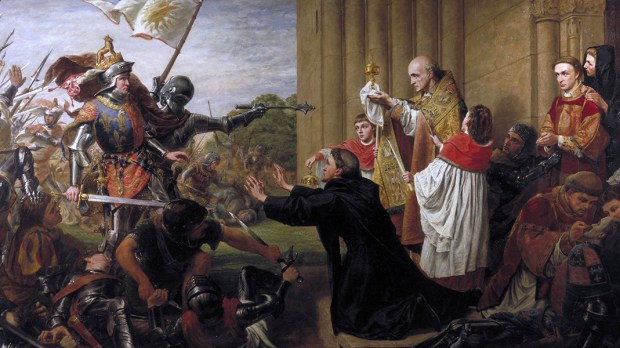Lenten Campaign 2025
This content is free of charge, as are all our articles.
Support us with a donation that is tax-deductible and enable us to continue to reach millions of readers.
Like many Catholics after the Notre Dame fire, we turned to the Disney animated classic The Hunchback of Notre Dame for a glimpse at the stellar job they did recreating the famous French cathedral. Everyone knows of the dramatic climax, where Quasimodo saves Esmeralda from execution and rushes her to Notre Dame in order to cry “Sanctuary!” and stay Esmeralda’s sentence. But did you know there was a time when this was common for those who had run astray of the law?
Claiming sanctuary in a church is a practice that predates Christianity, going as far back as the Greek and Roman pagan temples. Early Christian churches offered their own protections for their congregations, and when Rome adopted Christianity in the 4th century, sanctuary became a permanent part of Roman imperial law.
The fall of the Roman Empire did not change the traditions of the Church, and it continued to offer protection from secular authorities. History.com spoke to says Karl Shoemaker, a professor of history and law at the University of Wisconsin, who wrote the book on Sanctuary and Crime in the Middle Ages. He explained that consecrated churches were treated as “safe spaces”:
“It would be inappropriate in the extreme to carry weapons into the church or to arrest someone or to exercise force within the church.” In addition, the church was “deeply suspicious about the punishments meted out by secular authority,”
The Church believed in “restoring the moral balance between the wrongdoer and God,” and felt that secular authorities often ignored this aspect, preferring to punish without rehabilitation. Sanctuary was seen as a time for a criminal to heal his or her relationship with God, and included conversion for non-Christians who sought sanctuary.
The most common crimes for which fugitives sought sanctuary were murder and theft. Once a person was in the church and had claimed sanctuary, usually by laying a hand on the altar, pursuers could lie in wait outside of the building, but they could not enter to forcibly remove the fugitive. On the other hand, the fugitives could not bring arms into the church — for instance, they could not bring a bow and arrow to shoot at their pursuers from a high window.
There were few options for an individual who had claimed sanctuary. There was a brief time in which they could attempt to make amends to those they wronged, in hopes that the charges could be dropped, but this was uncommon. Even more rare was receiving a royal pardon for their crimes, but it was possible.
More often than not, the criminals would be forced into exile from their city, region, or even the whole country. This was most common in 12th-century England, a society that regulated sanctuaries more than any European nation. Once an English citizen had claimed sanctuary they would have to leave the country for the rest of their lives. The English also limited the duration of sanctuary to no more than 40 days.
Although England installed strict regulations on the practice, it didn’t always adhere to the laws. History.com cites an instance where a woman killed a priest in church and then attempted to claim sanctuary on the spot. After legal discussions it was ruled that she could not claim sanctuary in the church because she had just desecrated it. The case of St. Thomas Becket, who was killed inside his cathedral by the king’s own men, was not a case of sanctuary violation but one of sacrilege, for which King Henry II himself did physical penance.
The English practice of sanctuary began to die off as the ruling class found that they could take advantage of the safety, often remaining in the church as long as they wanted. Eventually the Church restricted the crimes for which sanctuary could be sought, and the practice was formally banned in England in 1623 as part of the English Reformation.
The practice has not died out completely, however, and even today there are instances when a church might go above and beyond the call of duty to protect those in need. History.com cites such an instance of a church in The Hague, in 2018, which protected a family seeking asylum from deportation for 96 days by holding round-the-clock services. Under Dutch law, police cannot enter religious institutions during rites, so the church continued their Masses until the family was granted more time.

